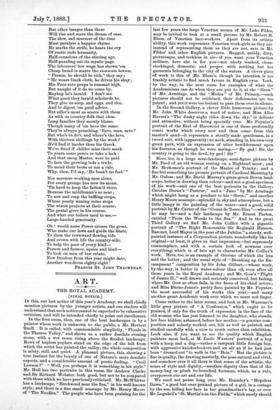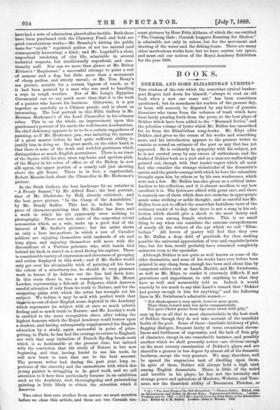ART.
THE ROYAL ACADEMY.
[FINAL NOTICE.]
IN this, our last notice of this year's Academy, we shall chiefly mention pictures by the younger artists, and our readers will -understand that such notice cannot be expected to be exhaustive criticism, and will be intended chiefly to point out excellences. In the first room, then, one of the best landscapes is by a painter whose work is unknown to the public, a Mr. Herbert Snell. It is called, with commendable simplicity, "Floods in -the Thames Valley," and shows us a rather desolate evening scene, with a wet moon rising above the flooded landscape. Rows of hapless poplars stand on the edge of the hill from which the artist has painted the valley; the whole composition is misty, still, and quiet. A pleasant picture, this, showing a true instinct for-the beauty of one of Nature's more desolate aspects, and a considerable amount of poetic feeling. "Cecil Lawson F' "Well, yes, perhaps it is something in his style." Mr. Holl has two portraits in this room, Sir Andrew Clarke and Sir Richard Webster, both good, but not to be compared with those which we have previously criticised. Mr. McWhirter has a landscape, "Birchwood near the Sea," in his well-known style; and there is a fine small seascape by Mr. Henry Moore of "The Needles." The people who have been praising for the
last few years the large Venetian scenes of Mr. Luke Fades, may be invited to look at a small picture by Mr. Robert H.
Blum, of Venetian lace-workers. Apart from its artistic ability, this work represents Venetian work-girls as they are instead of representing them as they are not, save in Mr. Fildes' and other English pictures. Ragged, untidy, dirty, picturesque, and reckless in air—if you want your Venetian milliner, here she is , for you—not nicely washed, clean. stockinged, domestic, and proper, with nothing but her garments belonging to the city of the waters. A clever piece of work is this of Mr. Blum's, though its intention is too frankly artistic to find much favour in English eyes. Look, by the way, in the next room for examples of what the Academicians can do when they are put to it, at the " Siren " of Mr. Armitage, and the " Medea " of Mr. Prinsep,—such pictures should not be criticised, their deficiencies are too patent ; and yet it were too lenient to pass them over in silence.
In the Second Gallery, a clever little humorous picture by Mr. John White deserves a word of notice; and Miss Alice Havers's "The dusky night rides down the sky," is delicate and attractive, without being specially true. Mr. Poynter's portrait of the Earl of Harewood is one of those profoundly comic works which every now and then come from this master's easel—it represents a stoutly made gentleman, in a tweed suit, with (apparently) no neck, standing in his own very green park, with an expression of utter bewilderment upon his features, as though he were saying,—" By gad ! Sir, the country is going to the devil, by gad ! Sir."
Here, too, is a large semi-landscape, semi-figure picture by Mr. Faed of an old woman resting on a Highland moor; and Mr. Herkomer's portrait of the Master of Trinity; and a fine but something too prosaic portrait of Cardinal Manning by Mr. Onless ; and Mr. David Murray's grass-green Devon land- scape, better in drawing than colour—and not a good specimen of his work—and one of the best portraits in the Gallery, Carolus Duran's "Pasteur ;" and a " Juno " by Mr. Armitage which might hang as a pendant to his " Siren ;" and another Henry Moore seascape—splendid in sky and atmosphere, but a little lumpy in the painting of the water—and a good, solid portrait by Mr. Carter of the "Count de Torre-Diaz "—whoever he may be—and a fair landscape by Mr. Ernest Parton, entitled "From the Woods to the Sea." And in the great Third Gallery we find Mr. John Collier with a gigantic portrait of "The Right Honourable Sir Reginald Hanson, Baronet, Lord Mayor in the year of the Jubilee," a sturdy, well. painted instance of a Corporation picture, wonderfully like its original—at least, it gives us that impression—but supremely commonplace, and with a certain look of newness over everything, which is of late apt to characterise Mr. Collier's work. Here, too, is an example of Gerome of which the less said the better ; and the usual style of "Breaking up the En- campment" composition by Sir John Gilbert,—whose work, by-the-way, is better in water-colour than oil, even after all these years in the Royal Academy; and Mr. Gow's "Flight of James II.," well drawn and seriously conceived, but failing, where Mr. Gow so often fails, in the faces of his chief actors; and Miss Burne-Jones's pretty face, painted by Mr. Poynter, the most successful of his works this year,—and many another great Academic work over which we must not linger.
Come rather to the later rooms, and look at Mr. Warrener's little grey picture of "A Confession," which ought to be praised, if only for the truth of expression in the face of the old woman who has just listened to the daughter, who stands, her face hidden, ashamed, before her mother,—a genuine com- position and soberly worked out, felt as well as painted, and studied carefully with a view to truth rather than exhibition. Look also, if you want to see the quality which English painters most lack, at M. Emile Wauters' portrait of a boy with a hoop and a dog,—rather a rampant little foreign boy, with aggressive knickerbockers and an air as if he had just been "dressed out "to walk in the "Bois." But the picture is fine in quality, the drawing masterly, the pose natural and vivid, and somehow over it all there is that sense of the artistic, the sense of style and dignity,—another dignity than that of the money-bag or plush be-breeched footman, which, as a, rule, overpowers our art and our life.
We need not pause long over Mr. Bromley's "Hopeless Dawn," a good but over-praised picture of a girl, in a cottage by the sea, hiding her face in her grandmother's lap, or over Mr. Logsdon's "St. Martin's-in-the-Fields," which surely should
have had a note of admiration placed after its title. Both these have been purchased with the Chantrey Fund, and both are good conscientious works,—Mr. Bromley's hitting the public taste for " nicely " regulated pathos of not too natural (and consequently harrowing) a kind ; and Mr. Logsdail's a clear, nnpoetical rendering of city life, admirable in several technical respects, but intellectually superficial, and emo- tionally null. Nor can we more than glance at Mr. Briton Riviere's " Requiescat," a successful attempt to paint a suit of armour and a dog, but little more than a monument of cheap pathos, and utterly unreal ; or Mr. Tom Hemy's sea picture, notable for a certain bigness of touch, as if it had been painted by a man who was used to handling a rope in rough weather. Nor of Mr. Long's Egyptian Ceremonial can we say much more than that it is the work of a painter who knows his business. Otherwise, it is put together as carefully as a Chinese puzzle, ana is about as interesting. The best portrait in this Fifth Gallery is Mr. Herman Herkomer's of the Lord Chancellor in his crimson robes. This is, on the whole, an improvement upon this gentleman's portrait of his uncle, the well-known Academician. Its chief deficiency appears to us to be a certain raggedness of painting, as if Mr. Herkomer, jun., was imitating the manner of a great master before he had quite sufficient ability to justify him in doing so. Its great merit, on the other hand, is that there is none of the weak and well-fed prettiness which distinguishes so much English portraiture. There is no trace of the Squire with his nice, clean top-boots and spotless pink, of the Mayor in his robes of office, or of the Bishop in new silk apron, the upper portion of a comely calf just showing above the gilt frame. There is, in fact, a vagabondish, Robert Macaire look about the Chaneellor in Mr. Herkomer's picture.
In the Sixth Gallery, the best landscape by an outsider is "A Frosty Sunset," by Mr. Alfred East ; the best portrait, that of Mr. Gladstone, by Roll, already criticised ; and the best genre picture, "In the Camp of the Amalekites," by Mr. Dandy Sadler. This last is, indeed, the best piece of character-painting that Mr. Sadler has done, and a work in which his art apparently owes nothing to photography. There are here none of the somewhat trivial accessories which, as a rule, make up a good deal of the interest of Mr. Sadler's pictures ; but the artist shows us only a bare inn-parlour, in which a row of Cavalier soldiers are enjoying themselves with tankards of ale and long pipes, and enjoying themselves still more with the discomfiture of a Puritan prisoner, who, with hands tied behind his back, is seated on a stool facing his captors. There is considerable variety of expression and cleverness of grouping and action displayed in this work ; and if Mr. Sadler would only get over his abominable trick of painting all his faces the colour of a strawberry-ice, he should do very pleasant work in future if he follows out the line laid down here. In this room there is, too, a composition by Mr. Mount Louden, representing a fish-sale at Polperro, which deserves careful attention if only from its truth to Nature, and for the unsparing pains with which the artist has wrought out his subject. We believe it may be said with perfect truth that thew is no out-of-door English scene depicted in the Academy which represents its subject with at once so much artistic feeling and so much truth to Nature; and Mr. Loudan's work is entitled to the more recognition since, after taking the highest honours which the Royal Academy could bestow upon a student, and having subsequently supplemented his English education by a study, again successful in point of prize- getting, in Paris, he has had the courage to return to England, not with that easy imitation of French flip-flap brush-work which is so fashionable at the present time, but imbued with the conviction that his study of Nature is but now beginning, and that, having learnt to use his tools, he will now learn to turn that use to the best account. The present writer had, during the past year, long ex- perience of the sincerity and the earnestness with which this young painter is struggling to do good work, and we call attention to it here thus particularly because in an exhibition such as the Academy, such thoroughgoing and painstaking painting is little likely to obtain the attention which it deserves.
Two other first-rate studies from nature we must mention before we close this article, and these are two Cornish sea-
coast pictures by Herr Fritz Althaus, of which the one entitled "The Coming Gale : Cornish Luggers Running for Shelter," is admirable not only in colour, but for the movement and drawing of the water and the fishing-boats. There are many other meritorious works here, but we have outrun our space,. and must end our notices of the Royal Academy Exhibition for the year 1888.



































 Previous page
Previous page